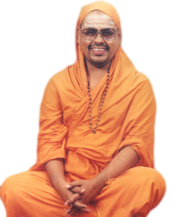This spiritual journey, that is intellectual, is divided
into three segments, of which the first segment is Jnana yogyata prapthi;
Jnana prapthi and Jnana nishta prapthi being the other two segments
in that order. Jnana yogyatha prapthi means to equip oneself intellectually to engage in the
pursuit of this knowledge. This involves
understanding the importance of jnanam and understanding the need for a
Guru and understanding the importance of scriptural study. In addition to the
intellectual preparation, emotional preparation is also needed as one must have
an undisturbed mind to absorb the teaching.
This emotional preparation is done through the practice of sadhana
chathushtayam, the four-fold means of practice to be cultivated by a serious
student of Self-knowledge, comprising viveka, vairagya, samadhi shadka
sampatti and mumukshutvam. This
is discussed in detail in Sri Sankara’s work, Tattva Bodha. Further the
practice of two sadhanas, karma yoga and upasana yoga are
prescribed in this first segment. While
practicing the karma yoga and upasana yoga one does not treat
them as an end in itself for getting Moksha but as a means of preparing
the mind and intellect for the next level called Jnana prapthi. In fact, in upasana
yoga the meditation is not on getting Moksha but on getting ready
for Self-enquiry, emotionally and intellectually. One should not treat the karma
yoga and upasana yoga as end in the themselves but as means to
acquire chittha suddhi and chitta ekagratha which will facilitate
gaining Jnanam at the next level, Jnana prapthi.
The Jnanam discussed in Vedanta sastra is Athma-Jnanam, Knowledge of one’s Self, i.e., Athma, that is Brahman. Scriptures alone deal with this knowledge, the knowledge of Self, the observer. The physical sciences analyse only the observed universe and phenomena and not the observer Self. This Self-knowledge is gained through two exercises, Sravanam and Mananam. Brihadharanyaka Upanishad gives the prescription for Athma Jnanam in the words of Sage Yajnavalkya to his wfe, Maitreyi (2-4-5) “Atma va are drstavyah srotavyo mantavyo nidhidhyasitavyo Maitreyi” O! Maitreyi, Athma is to be discovered through Sravanam, Mananam, Nidhidhyasanam”. Of the three the first two i.e. Sravanam and Mananam come under Jnana prapthi and the third Nidhidyasanam comes under Jnana Nishta prapthi, the third and last level that we shall see later. Sravanam is consistent, systematic study of Sastras under a competent Guru. The scriptural teaching by a competent Guru helps as a verbal mirror to discover one’s true Self removing Self-ignorance. This is emphasised in Mundaka Upanishad (1-2-12): “tat vignanaartham sa gurumevaabhigaccheth samithpanih shrothriyam Brahmanishtham (To know That (Athma), he (the seeker) should go to a Guru, who is both learned in the scriptures and established in the knowledge, with the sacred fuel in hand (as a disciple))”. One learns there that the limitless Brahman, which existed before the universe came, which exists now also and which will ever exist; that Brahman is not one of the objects in the creation but it is nothing but one’s Real Self. One cannot accept easily that one is not the limited individual but the limitless Brahman and to convince oneself one has to remove all questions and doubts one’s intellect may raise. This process of raising questions and doubts and having them cleared through one or more steps of deep thinking, group discussion with fellow students, seeking Guru’s help is called Mananam. Thus through Sravanam and Mananam one gets “Aham Brahma asmi (I am Brahman)” Jnanam, the knowledge of the identity of Brahman and Athma, the individual self, doubt-free. Thus shifting jiva bhava to Brahma bhava is Jnana prapthi.
Now after gaining this Jnanam that one’s real Self is Athma, the Brahman, one needs to assimilate and internalise the knowledge so that one is conscious of the Brahma bhava in all interactions with the external world. This is done at the last level, Jnana nishta prapthi which is called Nidhidhyasanam process. Nidhidhyasanam helps internalisation or assimilation of the doubt-free knowledge, deconditioning all the negative emotions developed in the dark room of ignorant mind. This is done by constantly meditating on the teaching which is free from all doubts. While Mananam is for removal of intellectual obstacles, Nidhidhyasanam is for removal of mental and emotional obstacles like worry, guilt, anger, fear, hurt etc. This is called Vedantic meditation as it involves meditating upon the Vedantic teachings including Mahavakhyas. Through this process deliberate negation of Jiva Bhava along with the weakening of mamakara and ahamkara accompanied by the conscious assertion of Brahma bhava is done. And when one revises one’s status, parallelly the status of Moksha will also get revised. Moksha is usually described as freedom from the cycle of birth and death. Now with Jnana prapthi one discovers that his Real Self is Athma that is Brahman, which is eternal and has no birth or death and not the mortal body-mind complex that is subject to birth and death. So for him now Moksha is a siddha vasthu, an attained one, in fact an ever-attained one, and not a sadhya vasthu, a goal to be reached. So there is a shift in outlook from ‘seeking Moksha’ to ‘claiming Moksha as one’s svarupam’. So attaining Jnana Nishta, one not only changes from Jiva Bhava to Brahma bhava totally but also revises one’s Moksha status. There is an incidental benefit of emotional improvement due to the weakening of ahamkara and mamakara and reduction of raga and dvesha. Such a person who has attained Jnana Nishta is called a Jivanmuktha.
---------------------------

No comments:
Post a Comment